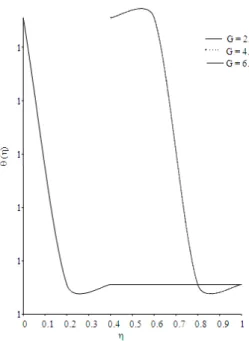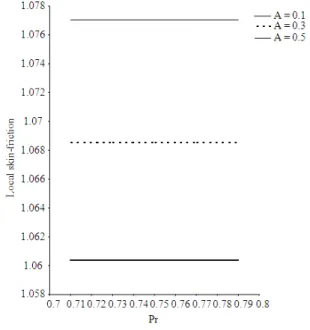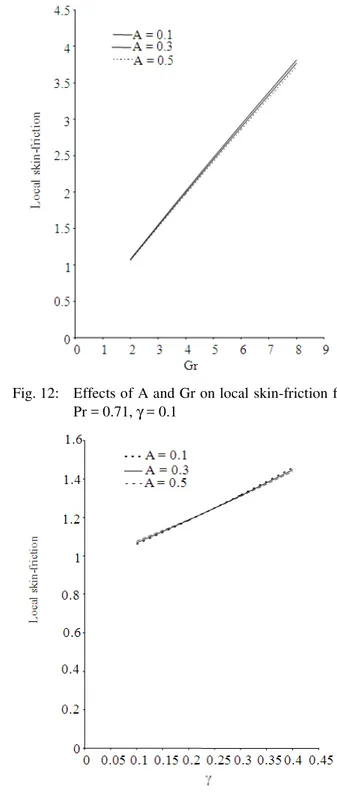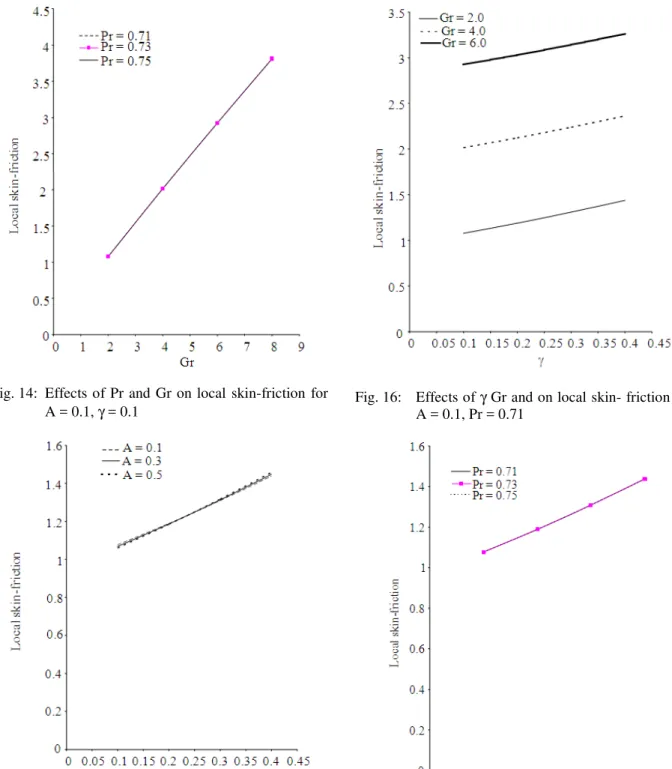ISSN 1549-3644
© 2010 Science Publications
Corresponding Author: O.K. Koriko, Department of Mathematical Sciences, Federal University of Technology, Akure
Similarity Solutions for Free Convection Between
Two Parallel Porous Walls at Different Temperatures
A.J. Omowaye and O.K. Koriko
Department of Mathematical Sciences, Federal University of Technology, Akure
Abstract: Problem statement: A two dimensional steady laminar free convective flow of viscous incompressible fluid between two parallel porous walls is considered. Approach: Using the similarity variable, the partial differential equations were reduced to ordinary differential equations. The coupled ordinary differential equations were solved numerically using shooting method. The effect of various physical parameters, such as the Prandtl number, Grashof number, permeability parameter and ratio of the free stream velocity to parallel wall parameter on the boundary layer velocity and skin-friction coefficient were investigated. Results: Some of the several important findings of the results were (i) the fluid velocity increased as either of the Grashof number, permeability parameter, ratio of free stream velocity parameter to parallel wall parameter was increased. (ii) The fluid temperature decreased as either of the Grashof number, ratio of free stream velocity parameter to parallel wall parameter increased and increased as permeability parameter was increased. (iii) Skin friction increase owing to an increase in Grashof number, ratio of free stream velocity parameter to parallel wall parameter and decrease with increasing permeability parameter. In this study, a similarity solution for free convective flow between two parameter porous walls situated a distance L apart was considered. Numerical results were presented to illustrate the details of the flow, skin-friction characteristics and their dependence on the flow conditions and fluid properties. Conclusion: In particular, we found that, the fluid velocity increased as either of the Grashof number, permeability parameter, ratio of free stream velocity parameter to parallel wall parameter was increased.
Key words: Free convection, porous medium, similarity solution, parallel wall, boundary layer INTRODUCTION
There are several situations where forced and natural convection occur with relatively comparable significance. This case is referred to as mixed convection heat transfer. Accurate knowledge of the overall convection heat transfer is important in many fields, including heat exchangers, hot water and stream pipes heaters, refrigerators and electrical conductors. Because of its industrial importance, this class of heat transfer has been the subject of many experimental and analytical studies (Bassam and Abu-Hijleh, 2002).
Chaudhary and Merkin (1994) discussed the free convection boundary layer flow on a vertical surface which results when there was an exothermic catalytic chemical reaction on that surface. The system was seen to be governed by the two dimensionless chemical parameters ε and α which were measures of the activation energy and heat of reaction respectively, as well as the Prandtl and Schmidt numbers. A series solution was obtained valid near the leading edge of the plate and this was continued downstream by numerical
velocity and temperature distributions were discussed numerically and presented through graphs. Skin-friction coefficient and the Nusselt number at the sheet were derived, discussed numerically and then numerical values for various values of physical parameter were presented through tables. It was observed that fluid velocity decreases due to increase in the Hartmann number for λ<1 while reverse effect is observed when
λ>1 and there was boundary layer formation when λ = 1. Prasad and Kulachi (1984) discussed numerical solutions for two-dimensional steady, free convection for rectangular cavity with constant heat flux on one vertical wall, the other vertical wall being isothermally cooled. The horizontal walls were insulted. Results were presented in terms of streamlines and isotherms, local and average Nusselt numbers at the heated wall and the local heat flux at the cooled wall flow patterns were observed to be quite different from those in the case of a cavity with both vertical walls at constant temperatures. Specifically, symmetry in the flow field is absent and any increase in applied heat flux was not accompanied by linearly proportional increase in the temperature on the heated wall. Also, for low Prandtl number, the heat transfer rate based upon the mean temperature difference is higher as compared to experimental results for the isothermal case. Heat transfer results, further indicate that the average Nusselt number is correlated by a relation of the form Nu = constant * m n
a
R A where * m a
R is the Rayleigh number and A the height to-width ratio of the cavity. Mahanti and Gaur (2009) investigated the effects of linearly varying viscosity and thermal conductivity on steady free convective flow of a viscous incompressible fluid along an isothermal vertical plate in the presence of heat sink. The governing equations of continuity, momentum and energy were transformed into coupled and non-linear ordinary differential equations using similarity transformation and then solved using Runge-Kutta fourth order method with shooting technique. They showed that the velocity and temperature of the fluid decrease with the increase in Prandtl number. Skin- friction coefficient decrease while rate of heat transfer increases with the decrease in the heat sink. Mahapatra and Gupta (2001) reported MHD stagnation point flow towards isothermal stretching sheet and pointed that velocity decreases/increases with the increase in magnetic field intensity when free stream velocity is smaller/greater respectively than the stretching velocity.
From the existing literature non has studied, free convective flow between parallel porous walls maintained at different temperatures. Therefore, this study will be devoted to it.
MATERIALS AND METHODS
Mathematical formulation of the problem: Consider a two-dimensional steady laminar free convection flow of a viscous incompressible fluid between two parallel porous walls situated a distance L apart. The x-axis is taken along the wall and y-axis is transverse to the parallel walls. The fluid is injected into the lower wall at y = 0 and is sucked through the upper wall with uniform velocity, under the usual Boussineq’s and boundary layer approximation, the governing equations for conservation of mass, momentum and energy respectively are as follows:
u v
0
x y
∂ +∂ =
∂ ∂ (1)
2
2
u u 1 p u
u v g (T T ) u
x y x y ∞ K
∂ + ∂ =− ∂ +ν∂ + β − − ν
∂ ∂ ρ ∂ ∂ (2)
2
2 p
T T k T
u v
x y c y
∂ + ∂ = ∂
∂ ∂ ρ ∂ (3)
Where:
u,v = Fluid velocity in the x,y direction p = pressure
k = Thermal conductivity
cp = Specific heat capacity at constant pressure.
ν = Kinematic viscosity T = Fluid temperature
Ρ = Density of the fluid
K = Permeability of the porous medium
Β = Coefficient of thermal expansion x,y = Cartesian coordinate along x and y axes.
The boundary conditions of the problem under consideration are:
u 0, v 0, T T , y 0
u u T T , y
∞
∞ ∞
= = = =
→ → → ∞ (4)
Where:
u∞ = Free stream velocity T∞ = Free stream temperature
Tw = Temperature of the horizontal wall
In the free- stream velocity u∞= u(x) = bx where b is the free stream velocity parameter. Equation 2 becomes:
1 p d u
u u
x K d x
∞ ∞ ∞
∂ ν
− − =
Eliminating p x ∂
∂ between Eq. 2 and 5, we get:
2
2
u u d u u
u v u g (T T ) (u u)
x y d x y K
∞
∞ ∞ ∞
∂ + ∂ = + ν∂ + β − +ν −
∂ ∂ ∂ (6)
Method of solution: Introducing the stream function
ψ(x,y) as define by:
u and v
y x
∂ψ ∂ψ
= = −
∂ ∂ (7)
The similarity variable
1 2 (c / ) y η = ν and
1 2 (x, y) (c ) xf ( )
ψ = ν η (8)
Where:
c = The parallel wall parameter
η = The similarity variable
ν = Kinematic viscosity
ψ = The stream function and the dimensionless temperature is given as:
w T T ( ) T T ∞ ∞ − θ η =
− (9)
Equation 7-9 into Eq. 3 and 6, we get:
' ' ' ' ' ' 2 ' 2
f +f f −(f ) + θ+Gr A (γ −f )+ γ =0 (10) ' ' '
Pr f 0
θ + θ = (11)
where the Grashof number w 2 g (T T ) Gr
c x ∞
β −
= , the
permeability parameter A 1 Kc
= , the ratio of the free stream velocity parameter to parallel wall parameter
b c
γ = , the Prandtl number cp Pr
k µ
= . It is noted that Eq. 1 is identically satisfied. The corresponding boundary conditions are reduced to:
' '
f (0) 0 f (0) 0 f ( ) (0)
1 ( ) 0
= = ∞ = γ θ
= θ ∞ = (12)
The governing boundary layer and thermal boundary layer Eq. 10 and 11 with the boundary conditions (12) are solved numerically using shooting technique along with fourth order Runge-Kutta
integration. The basic idea of shooting method for solving boundary value problem ordinary differential equations is to try to find appropriate initial condition for which the computed solution “hit the target” so that the boundary conditions at other points are satisfied. Furthermore, the higher order non-linear differential Eq. 10 and 11 are converted into simultaneous linear differential equations of order first and they are further transformed into initial valued problem applying the shooting method incorporating fourth order Runge-Kutta. The iterative solution procedure was carried out until the error in the solution became less than a predefined tolerance level. Other predefined parameters needed for the solution method include the step length (h), Grash of number (Gr), Prandtl number (Pr), permeability parameter (A), ratio of free stream velocity to parallel wall parameter (γ). Extensive testing was carried out in other to determine the effect of these parameters. The testing includes the value of Gr (2.0, 4.0, 6.0), Pr (0.71, 0.73, 0.75), γ (0.1, 0.2, 0.3), A (0.1, 0.3, 0.5), thus results are shown in Fig. 1-17.
Skin-friction: Skin-friction coefficient at the wall is given by: ' ' w f 1 2
C xf (0)
c(c ) τ
= =
ρ ν
where, w
y 0
u v
y x =
∂ ∂
τ = µ +
∂ ∂
is the shear stress at the wall. Particular case: (i) In absence of Grashof number i.e. Gr = 0, the results of the present paper are reduced to those obtained by Kafoussians (1989).
RESULTS AND DISCUSSION
Fig. 1: Velocity distribution verses η when A = 0.1,
γ = 0.1, G = 2.0
Fig. 2: Temperature distribution verses η when A = 0.1,
γ = 0.1, G = 2.0
Fig. 3: Velocity distribution verses η when A = 0.1,
γ = 0.1, Pr = 0.71
Fig. 4: Temperature distribution verses η when A = 0.1,
γ = 0.1 and Pr = 0.71
Fig. 5: Velocity distribution verses η when γ= 0.1, G = 2.0 and Pr = 0.71
Fig. 6: Temperature distribution verses η when γ = 0.1, G = 2.0 and Pr = 0.71
Fig. 7: Velocity distribution verses η when Pr = 0.71, G = 2.0 and A = 0.1
While increase in Gr causes a decrease in the fluid temperature. This result is in agreement with what Sharma and Singh (2009) obtained. Figure 5 and 6 reveal the effect of permeability parameter (A) on the velocity and temperature profiles respectively.
Fig. 8: Temperature distribution verses γ when Pr = 0.71, A = 0.1 andG = 2.0
Fig. 9: Effects of A and Pr on local skin-friction for G = 2.0, γ = 0.1
Fig. 10: Effects of Gr and Pr on local skin-friction for A = 0.1, γ = 0.1
Fig.11: Effects of γ and Pr on local skin-friction for A = 0.1, Gr = 2.0
Figure 7 and 8 depict respectively the effect of ratio of free stream velocity parameter to parallel wall parameter (γ) on velocity and temperature profiles. It is found from Fig. 7 and 8 that the velocity increases whereas temperature decreases significantly.
Fig. 12: Effects of A and Gr on local skin-friction for Pr = 0.71, γ = 0.1
Fig. 13: Effects of A and γ on local skin-friction for Pr = 0.71, Gr = 2.0
Fig. 14: Effects of Pr and Gr on local skin-friction for A = 0.1, γ = 0.1
Fig. 15: Effects of A and γ on local skin-friction for Pr = 0.71, Gr = 2.0
Figure 9 and 10 confirm that the local skin-friction coefficient decreases, whereas Fig. 11 shows it increases. Figure 12-14, show the combined effects of A, γ, Pr and Gr on the local skin-friction coefficient.
Fig. 16: Effects of γ Gr and on local skin- friction for A = 0.1, Pr = 0.71
Fig. 17: Effects of Pr and γ on local skin-friction for Gr = 2.0, A = 0.1
velocity parameter to parallel wall parameter increases Fig. 13. The skin-friction coefficient does not change as Prandtl number increases Fig. 14. Figure 15-17 depict the effect of A, Gr, Pr and γ on the local skin friction coefficient. The local skin friction increases as A, Gr increases Fig. 15 and 16, whereas Prandtl number does not have effect on Fig. 17.
CONCLUSION
In this study, similarity solutions for free convective flow between two parallel porous walls at different temperature are studied theoretically. A set of similarity equations governing the fluid velocity and temperature was obtained by using an appropriate similarity transformation. The dimensionless locally similar and non-linear ordinary differential equations are solved numerically by using shooting method. From the present numerical investigation we may conclude that:
• The fluid velocity increased as either of the Grashof number, permeability parameter, ratio of free stream velocity parameter to parallel wall parameter was increased
• The fluid temperature decreased as either of the Grashof number, ratio of free stream velocity parameter to parallel wall parameter was increased and increased as permeability parameter was increased
• Skin-friction increases owing to an increase in Grashof number, ratio of free stream velocity parameter to parallel wall parameter and decrease with increasing permeability parameter
REFERENCES
Bassam, A.K. and Abu-Hijleh, 2002. Mixed convection from a cylinder with low conductivity Baffles in cross-flow. ASME J. Heat Transfer, 124: 1064-1071. Chaudhary, M.A. and J.H. Merkin, 1994. Free
convection boundary layers on vertical surfaces driven by an exothermic surface reaction. Quar. J. Applied Math., 47: 405-428.
Kafoussians, N.G., 1989. Flow through a porous medium in the presence of heat transfer. Int. J. Eng. Fluid Mech., 2: 343-346.
Mahanti, N.C. and P. Gaur, 2009. Effects of varying viscosity and thermal conductivity on steady free convective flow and heat transfer along an isothermal vertical plate in the presence of heat sink. J. Applied Fluid Mech., 2: 23-28.
Mahapatra, T.R. and A.S. Gupta, 2001. Magneto hydrodynamics stagnation flow towards a stretching sheet. Acta Mech., 152: 191-196. Pathak, G. and C.H. Maheshwari, 2006. Effects of
radiation on unsteady free convection flow bounded by an oscillating plate with variable wall temperature. Int. J. Applied Mech. Eng., 11: 371-382. Prasad, V. and F.A. Kulucki, 1984. Natural convection
in a rectangular porous cavity with constant heat flux on one vertical wall. ASME J. Heat Transfer, 106: 151-157.
Sharma, P.R. and G. Singh, 2008. Unsteady MHD free convection flow and heat transfer along a vertical porous plate with variable suction and internal heat generation. Int. J. Applied Math. Mech., 4: 1-8. Sharma, P.R. and G. Singh, 2009. Effects of variable



